SAFETY DISCLAIMER: This article is meant to be an overview and not a detailed guide on rescue carrying and dragging techniques. Seek professional training before attempting to use any tools or techniques discussed in this story.
I have been a firefighter for over 20 years and relocating people away from precarious or deadly incidents is an essential component of my job. Among the seemingly endless tactics a firefighter is taught from day one, the ability to remove someone from harm is near the top of the list. Life safety is the top priority and whether you're moving someone from danger or delivering them to lifesaving medical aid, knowing safe and effective ways to conduct these maneuvers can make all the difference.
For many people, the general inclination is to carry someone as they've seen on television. Despite what Hollywood would have you believe, you will rarely, if ever, see someone carrying an adult victim out in front of them “cradle in arms” style. This can be used for an infant or child, but carrying a full-sized adult victim for any distance greater than a few feet, particularly over uneven terrain, is impractical and dangerous. Therefore you'll need to know the correct techniques to use when moving a victim and when you should employ them.
Once you've determined there's a need to remove someone from harm or get them to a position where they can receive help, quick but careful thought must be given to how this will be performed. There are two different categories of emergent victim removal: carries and drags. Each has their place and which one you should apply depends on several factors.
Victim Carries: When one or more rescuer is able to lift the victim and carry them to a location of safety.
Victim Drags: The movement of a victim by lifting part of their body as the other part drags — often used when a carry isn't possible or practical.
Regardless of whether you carry or drag a victim to safety, you must remember to keep your own safety a high priority. It doesn't sound heroic to say, but it does no good for anyone if you injure yourself and become part of the problem rather than the solution.
Moving a victim is harder than most realize. If the victim is conscious, pain from their injuries may cause them to shift their weight around while you're moving them, creating a scenario where your back or joints are forced into unnatural or unsafe positions — leading to a strong likelihood of rescuer injury. The victim may be vocal, crying or shouting, distracting you from your task, which also lends itself to injury.
If the victim is unconscious this creates a deadweight situation. They're unable to assist you in any way, tell you if you're hurting them, or causing greater injury by your movements. Also, the mental demands of moving an unconscious victim already increase the rescuer's anxiety out of concern.
The techniques discussed in the article are tried-and-true first responder techniques that are applicable to any survival situation. The way you choose to relocate a victim will depend on several factors and exact steps may vary depending on victim injury:
- How many victims are in need of rescue?
- How many rescuers are available?
- What are the capabilities and conditions of the rescuers?
- What is the size and condition of the victim(s)?
- What is the safety and stability of the environment?
One-Person Carries
You may be the only person available to help, or perhaps your team has already split up to render aid to multiple victims. Either way, there are times when you'll be forced to move someone by yourself. Carries conducted by a single rescuer can be extremely taxing on the rescuer. Adrenaline will work both for and against you. You may feel a sudden burst of energy and strength, but will lose it just as quickly. The body will compensate by relying on large muscle groups, such as the back, as this could result in rescuer injury. One-person carries should only be performed with the confidence that you won't cause injury to yourself or further injury to the victim.
One-Person Walk Assist
In mass-casualty training, we refer to people who can self- extricate with little or no assistance as walking wounded. If your victim is able to walk with only minor help from you, let them. The one-person walk assist offers the least chance for injury to both rescuer and victim.
Steps:
1. Place victim's arm around your neck and hold their wrist:
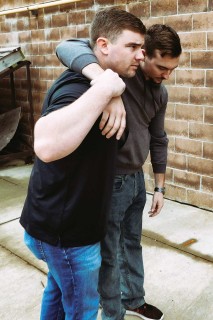
2. Place your arm nearest to them around their waist and walk with them to safety:
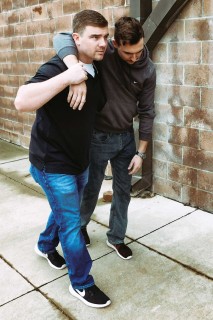
Above: Although the one-person walk assist is one of the easiest carrying and dragging techniques, never attempt to move anyone you think may have neck or spinal injuries without proper training.
Firefighter Carry
Made famous by the occupation, this type of carry should only be conducted by a very strong rescuer and a smaller victim. It'll require good lifting techniques as well as good core and lower body strength. Traversing uneven ground can be difficult because, with the victim in place, the rescuer becomes very top heavy. The firefighter carry can be used on either a conscious or unconscious victim.
1. With victim lying down, hook your elbows under their armpits:
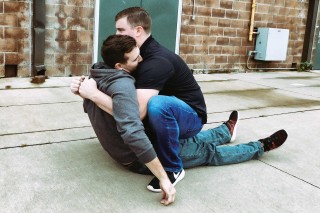
2. Raise them to a standing position:

3. Place your right leg between the victim's legs:
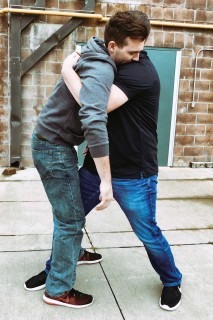
4. Grab the victim's right hand with your left:

5. Squat and wrap your right arm around the victim's right knee:
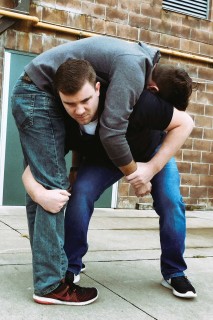
6. Stand and raise the victim's right thigh over your right shoulder
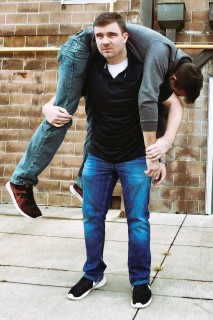
Pack Strap Carry
The pack strap carry has been utilized by the military for decades. It's a quick, down-and-dirty way to move a victim quickly. If not done correctly, this carry can be extremely uncomfortable for the victim. This is typically used on a conscious victim. For an unconscious victim, it can be done, but you may require assistance getting them into the position for you to safely follow the steps.
1. Facing away from the victim, place their arms over your shoulders:
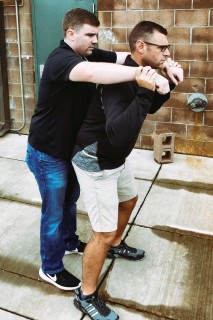
2. Cross the victim's arms grasping the opposite wrist and pull close to your chest:
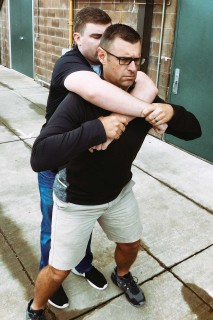
3. Squat, lean slightly forward, and drive your hips into the victim as you stand:
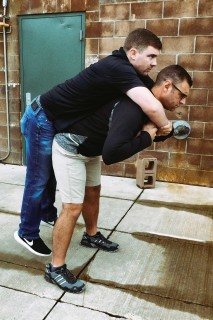
Two-Person Carries
The most safe and efficient way to carry a victim is by two rescuers. The rescuers can share the weight, help each other watch for hazards, and work together efficiently without crowding too many people around the victim. It also reduces rescuer fatigue, which allows the rescuers to cover a greater distance or to return to aid more victims.
Two-Person Extremity Carry
This is a common carry that's used by first responders and the military. It's easily performed, but best suited for moving a victim over even terrain, such as along a paved path or within a building. Both conscious and unconscious victims can be carried in this manner.
Steps:
- Help the victim to a seated position:
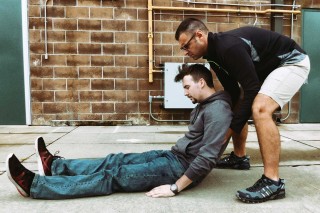
2. First rescuer kneels behind the victim, reaches under their arms, and grabs their wrists
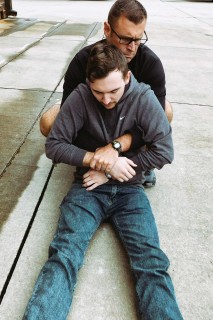
3. Second rescuer backs between the victim's legs, squats down, and grabs behind the knees:
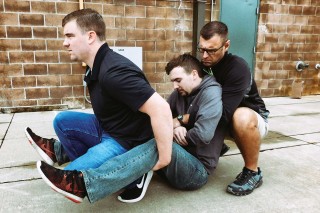
4. Stand at the command of the rescuer at the head, focusing on using your legs rather than your back:
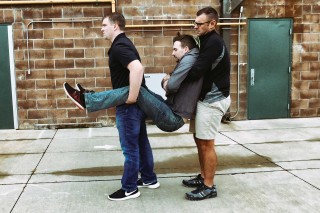
Chair Carry
One universal truth when speaking with anyone who prepares for catastrophe is that you use what's available to you. Moving victims is no different. A chair, for example, makes the transport of a victim significantly easier on the rescuers. This method is easier to perform with a conscious victim, but can be done with an unconscious victim as long as due care is taken.
Steps:
- Place victim in a sturdy chair:
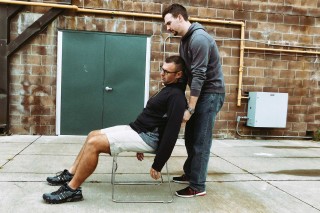
2. First rescuer stands behind, grabs the back of the chair, and leans it back on its hind legs:
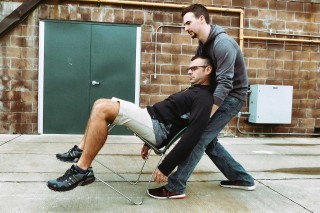
3. Second rescuer backs to the chair, squats down, and grabs the front legs of the chair:
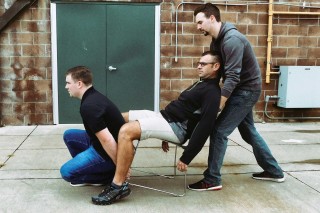
4. Stand at the command of the rescuer at the head:
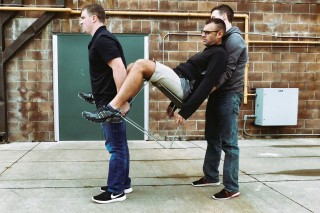
Two-Handed Seat Carry
The two-handed seat carry should only be conducted on conscious victims. Rescuers will utilize their arms to create a seat and the victim will need to be able to hold on for balance and stability.
1. Each rescuer should kneel on either side of the seated victim:
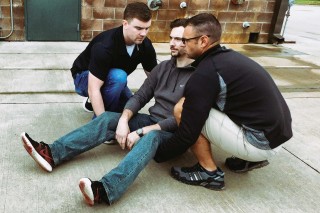
2. Link arms behind the victim's back:
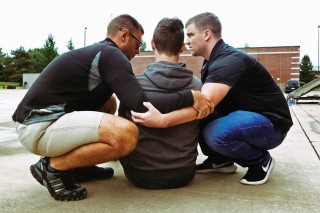
3. Place your free arms under the victim's knees and link arms:
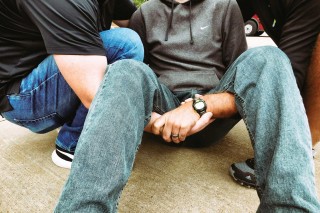
4. Place victim's arms around the shoulders of rescuers and stand together:
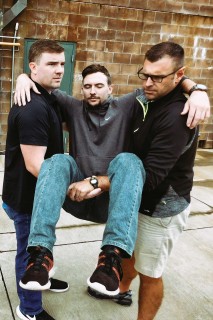
Drags
A victim drag is typically employed when victim removal is time-critical, or when the size of the victim prevents a safe carry. A coordinated carry is always the safer option, but under certain circumstances, a “grab ‘n' go” is necessary, particularly if the victim is unconscious. Oftentimes, though, when victims need to be relocated the terrain is uneven and treacherous, creating a dangerous scenario for both the rescuer and the victim. However, when a rapid extraction is necessary, a drag may be the only option. If at all possible, debris should be cleared from the path of the drag to reduce the chance for injury to the rescuer and further injury to the victim.
Blanket Drag
Along the same line of thought as the chair carry, utilize what you have available to you when performing a victim drag. The blanket drag can be performed with a blanket, or a sheet, curtains, towel, tarp, or anything else that'll accomplish the same goal.
Steps:
- Tuck the blanket under one side of the victim:
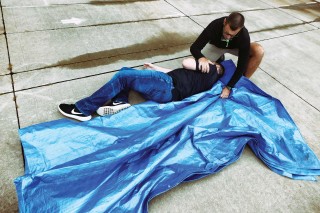
2. Roll the victim onto the blanket:
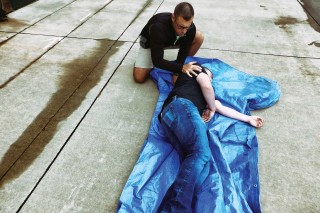
3. Adjust the blanket so the victim is centered:
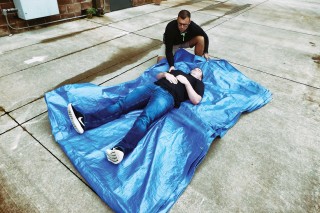
4. Grab the blanket by the end near the victim's head and drag to safety:
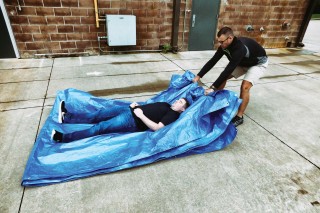
Shoulder Drag
The shoulder drag is another emergent maneuver for when a person needs to be moved quickly. This drag is difficult to perform over long distances as it's physically taxing on the rescuer.
Steps:
- Place victim in a seated position:
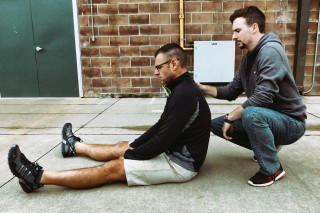
2. Squat behind the victim and reach under their arms grasping your own wrist:
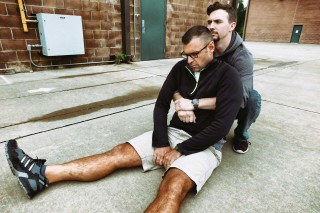
3. Stand, lean back, and walk backward dragging the victim to safety:
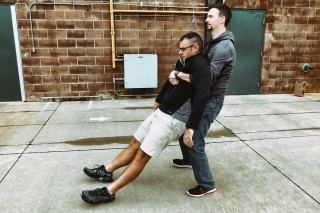
Feet Drag
The feet drag is a last resort. Moving a victim in this manner will most certainly be uncomfortable for the victim and will likely cause greater injury. It's a “life over limb” technique. This can really be accomplished only if the victim is unconscious because of the pain of dragging their torso and head along the ground.
Steps:
- Squat at the feet of the victim and grasp their ankles:
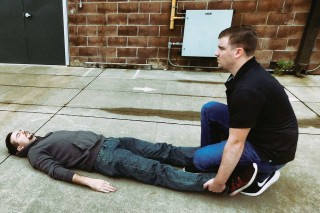
2. Stand, lean back, and drag:
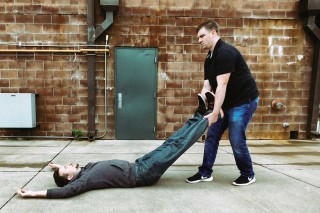
About the Author
Scott Finazzo has over 20 years of experience as a firefighter. He's a member of his department's technical rescue team and has served as an instructor since 2000. Scott has written five books, including the national bestselling The Prepper's Workbook and The Neighborhood Emergency Response Handbook, as well as his narrative of a kayak journey through the Virgin Islands called Why Do All the Locals Think We're Crazy? Follow Scott at www.scottfinazzo.com.
Read More
Subscribe to Recoil Offgrid's free newsletter for updates, offers and more.
The post Carrying & Dragging Techniques – Let’s Get Carried Away appeared first on RECOIL OFFGRID.
By: Offgrid Staff
Title: Carrying & Dragging Techniques – Let’s Get Carried Away
Sourced From: www.offgridweb.com/preparation/carrying-dragging-techniques-lets-get-carried-away/
Published Date: Mon, 18 Dec 2023 12:00:07 +0000
------------------------
Did you miss our previous article...
https://bushcrafttips.com/bushcraft-news/living-off-the-grid-with-no-money-can-you-do-it
 What is BushcraftSurvival SkillsToolsVideosBushcraft CampsBushcraft KitsBushcraft ProjectsPrivacy PolicyTerms And Conditions
What is BushcraftSurvival SkillsToolsVideosBushcraft CampsBushcraft KitsBushcraft ProjectsPrivacy PolicyTerms And Conditions
